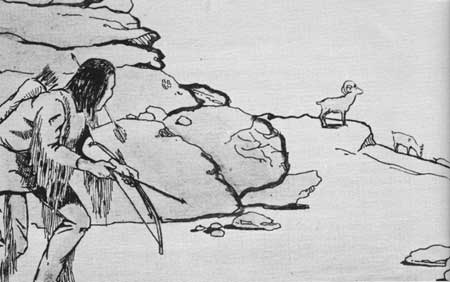|
ROCKY MOUNTAIN National Park |
 |
Man in the Rockies
At least a thousand years ago many Indians passed through the park region. Evidences of their presence are few but conclusive. Arrow points, hand hammers, and even crude pottery fragments have been collected, and some are on display in the Moraine Museum. In the past 200 years or so, the park was the haunt of the Utes (whose main territory was west of the Continental Divide) and, latterly, of the Arapahoes, who ranged the plains below the park. Many old Indian trails have been logged in the park; Trail Ridge was named from its Indian trail.
After the United States acquired the region through the Louisiana Purchase, a number of explorers and adventurers passed near the park in their travels, such as Long in 1820, Ashley in 1825, Dodge in 1835, Farnham in 1839, Wislizenus in 1839, Rufus Sage in 1840, Fremont in 1843 and 1844, Parkman in 1846, and Ruxton in 1847. From his narrative, there is reason to think that Sage might have been in Wild Basin; if so, this would mean that he was the first explorer to set foot in what is now Rocky Mountain National Park.
 BOTH UTE AND ARAPAHO INDIANS HUNTED IN THESE MOUNTAINS. (FROM AN EXHIBIT IN MORAINE PARK MUSEUM.) |
It was on October 15, 1859, that Joel Estes and his son topped Park Hill and saw what is now Estes Park. The next year, Estes settled his family in the grassy meadows here. The meadow—a "park" in Colorado terminology—quickly became known as Estes Park, a name still in familiar use. By 1867, the Estes family claim was acquired by Griff Evans, who later transferred his rights to a British nobleman, the Earl of Dunraven.
Dunraven's influence on the region was, perhaps, more beneficial than his antagonists would have admitted. Many enterprises, which would have seriously marred the matchless landscape, were kept out of his feudal regime, saving (although quite accidentally) many beauty spots for our later generation. He also did much to publicize the region; one of his guests was the artist Albert Bierstadt.
During the 1880's, a mining boom occurred in what is now the west side of the park, leading to the establishment of Lulu City, Dutchtown, and Teller. Grand Lake had already been discovered, and a small but rather exciting community grew up on its shore, serving the needs of the new mining camps. You can see the crumbling cabins of Lulu City by taking a 3-mile hike up the valley of the Colorado River.
By 1910, many people began thinking of a national park here, as that new invention, the automobile, was finally proving practicable as a means of travel. Although there were many supporters of the national park idea throughout the land, one man is credited with carrying the idea to a tangible result. This man was Enos Mills—a naturalist, philosopher, and writer. Years of hard work and innumerable frustrations were rewarded by his participation in the dedication ceremonies for Rocky Mountain National Park, held September 4, 1915.

|

|
| NPS History | History & Culture | National Park Service | Contact |
|
Last Modified: Sat, Nov 4 2006 10:00:00 pm PST |


